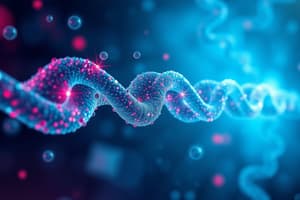Podcast
Questions and Answers
Which of the following components is NOT directly involved in the elongation of the new DNA strand during PCR?
Which of the following components is NOT directly involved in the elongation of the new DNA strand during PCR?
What is the main purpose of the denaturation step in PCR?
What is the main purpose of the denaturation step in PCR?
How does the concentration of Mg+2 affect PCR efficiency?
How does the concentration of Mg+2 affect PCR efficiency?
Why is Taq polymerase particularly suitable for PCR?
Why is Taq polymerase particularly suitable for PCR?
Signup and view all the answers
What is the role of primers in PCR?
What is the role of primers in PCR?
Signup and view all the answers
A researcher is trying to optimize PCR conditions for a specific target DNA fragment. Which of the following would NOT be a factor to consider when optimizing the reaction?
A researcher is trying to optimize PCR conditions for a specific target DNA fragment. Which of the following would NOT be a factor to consider when optimizing the reaction?
Signup and view all the answers
What is the significance of the fact that PCR is a cyclic process?
What is the significance of the fact that PCR is a cyclic process?
Signup and view all the answers
Which of the following factors is NOT directly related to the annealing temperature in PCR?
Which of the following factors is NOT directly related to the annealing temperature in PCR?
Signup and view all the answers
What is the primary reason why the concentration of the DNA template can affect PCR efficiency?
What is the primary reason why the concentration of the DNA template can affect PCR efficiency?
Signup and view all the answers
Which of the following statements about the annealing temperature in PCR is TRUE?
Which of the following statements about the annealing temperature in PCR is TRUE?
Signup and view all the answers
What happens if the annealing temperature is too low during PCR?
What happens if the annealing temperature is too low during PCR?
Signup and view all the answers
In the context of PCR, what does the term 'starter' refer to?
In the context of PCR, what does the term 'starter' refer to?
Signup and view all the answers
What is the primary function of MgCl2 in a PCR reaction?
What is the primary function of MgCl2 in a PCR reaction?
Signup and view all the answers
Assume you are designing primers for PCR, and you want to ensure optimal specificity. What is the most significant factor you should consider when choosing the primer annealing temperature?
Assume you are designing primers for PCR, and you want to ensure optimal specificity. What is the most significant factor you should consider when choosing the primer annealing temperature?
Signup and view all the answers
Which of the following is a potential consequence of using an excessively high concentration of dNTPs in a PCR reaction?
Which of the following is a potential consequence of using an excessively high concentration of dNTPs in a PCR reaction?
Signup and view all the answers
Why is it important to use a Taq polymerase in PCR?
Why is it important to use a Taq polymerase in PCR?
Signup and view all the answers
What is the most likely cause of a false-positive result in a PCR experiment, leading to the appearance of the product in a sample that does not contain the target sequence?
What is the most likely cause of a false-positive result in a PCR experiment, leading to the appearance of the product in a sample that does not contain the target sequence?
Signup and view all the answers
Which of the following statements accurately describes the role of the negative control in a PCR experiment?
Which of the following statements accurately describes the role of the negative control in a PCR experiment?
Signup and view all the answers
If a PCR experiment fails to yield any product in both the positive control and the tested samples, what is the most likely explanation?
If a PCR experiment fails to yield any product in both the positive control and the tested samples, what is the most likely explanation?
Signup and view all the answers
What is the primary purpose of preparing a MasterMix in a PCR experiment, as described in the provided content?
What is the primary purpose of preparing a MasterMix in a PCR experiment, as described in the provided content?
Signup and view all the answers
What is the implication of finding a PCR product in the negative control?
What is the implication of finding a PCR product in the negative control?
Signup and view all the answers
Which of the following factors is most likely to lead to a false negative PCR result due to its potential to inhibit the activity of DNA polymerase?
Which of the following factors is most likely to lead to a false negative PCR result due to its potential to inhibit the activity of DNA polymerase?
Signup and view all the answers
Which of the following is NOT a potential threat that could lead to a false positive PCR result?
Which of the following is NOT a potential threat that could lead to a false positive PCR result?
Signup and view all the answers
What is the primary effect of adding glycerol to the PCR reaction mixture?
What is the primary effect of adding glycerol to the PCR reaction mixture?
Signup and view all the answers
Which of the following is NOT a factor that can negatively impact PCR effectiveness?
Which of the following is NOT a factor that can negatively impact PCR effectiveness?
Signup and view all the answers
Which of the following BEST describes the effect of EDTA on PCR reactions?
Which of the following BEST describes the effect of EDTA on PCR reactions?
Signup and view all the answers
Which of the following is a potential source of contamination leading to false positive PCR results?
Which of the following is a potential source of contamination leading to false positive PCR results?
Signup and view all the answers
How can the addition of DMSO to the PCR reaction mixture improve PCR effectiveness?
How can the addition of DMSO to the PCR reaction mixture improve PCR effectiveness?
Signup and view all the answers
Why would an error in tube volume potentially result in a false negative PCR result?
Why would an error in tube volume potentially result in a false negative PCR result?
Signup and view all the answers
What is the primary reason why the use of proteinase K during DNA isolation can negatively impact PCR effectiveness?
What is the primary reason why the use of proteinase K during DNA isolation can negatively impact PCR effectiveness?
Signup and view all the answers
Which of the following is NOT a reason why low quality nucleic acids can result in false negative PCR results?
Which of the following is NOT a reason why low quality nucleic acids can result in false negative PCR results?
Signup and view all the answers
Why is the loading buffer essential in agarose gel electrophoresis?
Why is the loading buffer essential in agarose gel electrophoresis?
Signup and view all the answers
Study Notes
PCR (Polymerase Chain Reaction) Theory
- PCR is a technique used to selectively amplify DNA in a lab, mimicking natural DNA replication.
- It copies specific DNA sequences, which can be hundreds to thousands of nucleotides long.
- Kary Mullis developed PCR in 1987.
- PCR consists of three repeating stages (30-40 times):
- Denaturation: High temperature (94-95°C) breaks hydrogen bonds between DNA strands, separating them into single strands.
- Annealing/Hybridization: Lower temperature (3-5°C below the melting temperature of primers) allows short DNA primers to attach (anneal) to the complementary sequences on single strands.
- Elongation/Extension: A high temperature (72°C) activates a heat-stable DNA polymerase (e.g., Taq polymerase) which adds nucleotides to the 3' end of the primers, extending the DNA strands. This process is repeated, creating exponentially more copies of the target DNA sequence.
- The repeated cycles cause exponential amplification.
- The speed of elongation is typically around 1000 nucleotides per second.
- The efficiency of PCR is dependent on variables like DNA concentration, primers, and polymerase concentration. Differences in G+C bases affect the melting temperature (Tm).
PCR Components
- DNA template: The target DNA of interest (single or double-stranded, linear or circular).
- Primers: Short, single-stranded DNA fragments (complementary to the DNA sequence to be copied) that define the segment to be replicated and provide starting points for replication.
- dNTPs (deoxynucleotide triphosphates): These are the building blocks for DNA synthesis.
- DNA polymerase: An enzyme that adds dNTPs to the 3' end of the primers, synthesizing new DNA strands. Taq polymerase is commonly used.
- Buffer: A solution that maintains the pH and provides essential ions (e.g., magnesium ions) for the polymerase.
- Mg2+ ions: Critical cofactors for the polymerase.
- Other components (e.g., additives like BSA) can improve reaction efficiency and specificity.
PCR Optimization
- Several factors affect PCR efficiency (e.g., DNA matrix concentration, primer concentration, and concentration of monovalent/divalent cations).
- Optimization involves adjusting reaction conditions, including annealing temperature and concentration of dNTPs and Mg2+.
- Higher concentrations of dNTPs can increase the accuracy of DNA replication.
Threats to PCR
- False positives: Contamination with pre-existing DNA material or reagents.
- False negatives: Insufficient DNA concentration, presence of inhibitors/compounds within the sample.
Multiplex PCR
- A variation of PCR that simultaneously amplifies multiple DNA sequences in a single reaction by using multiple primer sets.
- This allows for parallel analyses.
PCR Practice
- Performing PCR for gender identification using SRY and FMR1 genes is a key application.
- The SRY gene is located exclusively on the Y chromosome, thus a specific PCR product from this gene indicates a male.
- The FMR1 gene is present in both males and females. PCR is used to ensure correct performance of the reaction (positive and negative control).
PCR Procedure
- Preparing PCR reagents, and reactions
- Pipetting components
- Cycling conditions are optimized depending on the DNA template
- Storing samples
- Identifying/visualizing products
Studying That Suits You
Use AI to generate personalized quizzes and flashcards to suit your learning preferences.
Related Documents
Description
Test your knowledge on the fundamental processes and techniques of Polymerase Chain Reaction (PCR). This quiz covers key concepts including denaturation, elongation, and the role of primers and MgCl2 in PCR efficiency. Perfect for students studying biotechnology or molecular biology.




